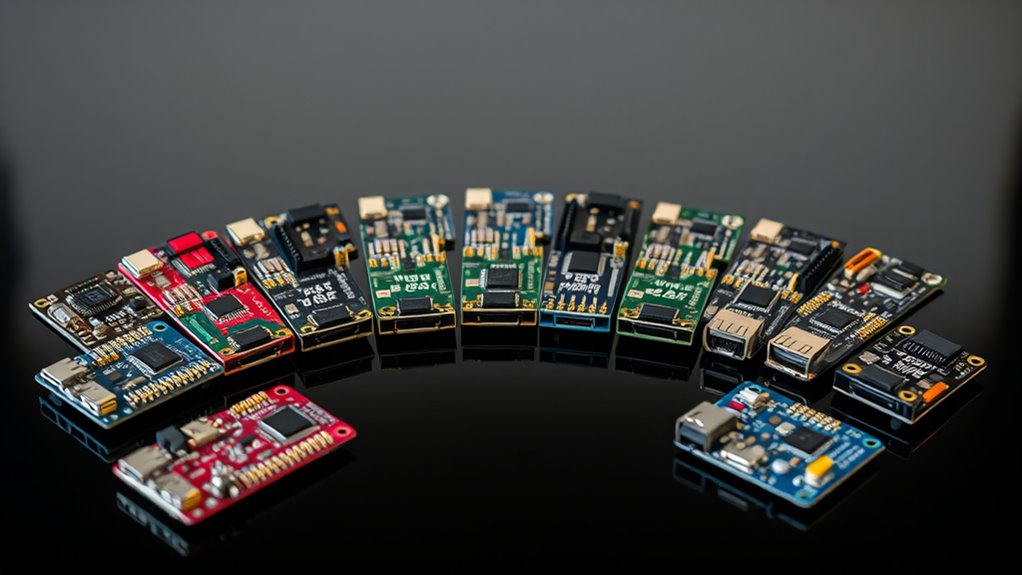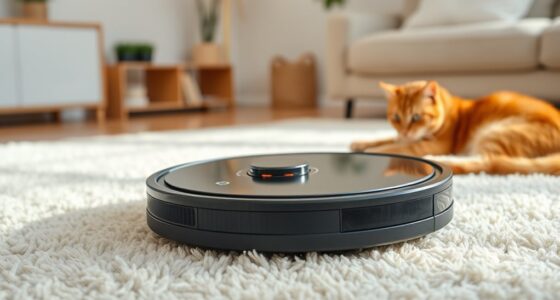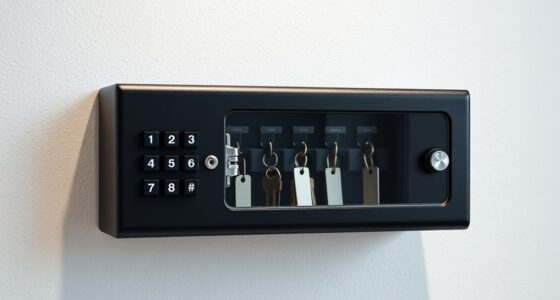If you’re looking for the 15 best microcontroller boards of 2025 for makers and innovators, I’ve got you covered. From beginner-friendly options like Arduino Uno REV3 and Nano V3.0, to compact boards with USB-C and advanced features like ESP-32 and STM32 Nucleo, there’s something for everyone. These boards offer reliable support, versatile connectivity, and great community backing. Want a closer look at each one? Keep going for detailed insights to help you choose the perfect platform.
Key Takeaways
- Highlights top microcontroller boards ideal for beginners, educators, and advanced developers in 2025.
- Covers boards with modern features like USB-C, WiFi, Bluetooth, and OTA support.
- Includes options suitable for IoT, automation, robotics, and complex embedded projects.
- Emphasizes reliability, community support, compatibility with Arduino IDE, and extensive peripherals.
- Details considerations like size, power management, driver compatibility, and project scalability.
3 pcs Nano V3.0 ATmega328P Microcontroller Boards with USB Cables
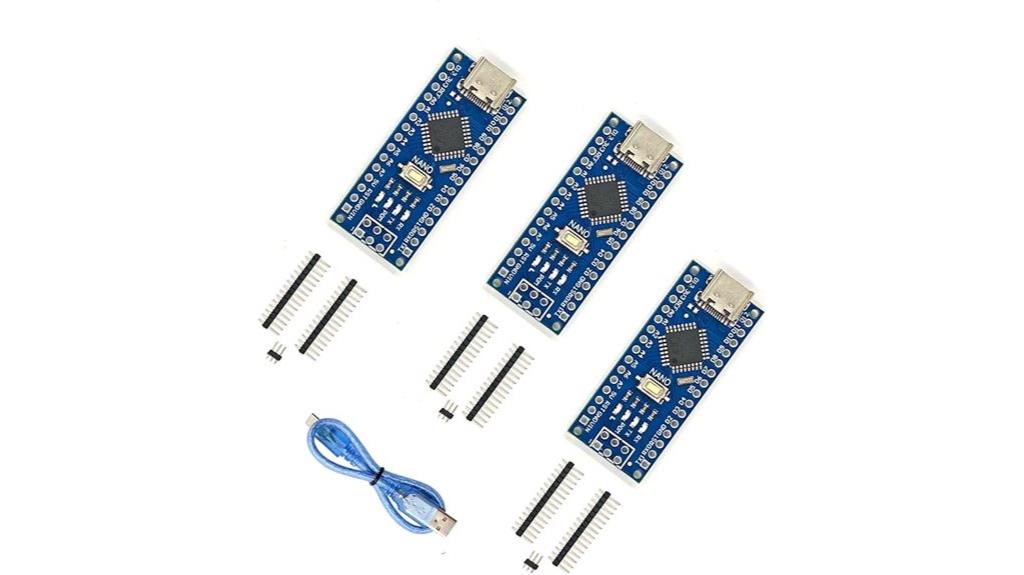
If you’re looking for an affordable, easy-to-use microcontroller board that’s perfect for both beginners and experienced makers, the pcs Nano V3.0 ATmega328P with USB-C is an excellent choice. These boards are compatible with the Arduino IDE, making programming straightforward. Based on the ATmega328P chip, they operate at 5V and 16MHz, ideal for various projects. The USB-C port enhances usability, and the boards come pre-flashed with a bootloader, so they’re ready to go. Compact and breadboard-friendly, they support easy integration into your designs. Plus, the CH340G chip ensures stable data transfer across different operating systems, making these boards versatile and reliable.
Best For: hobbyists, students, and DIY enthusiasts seeking affordable, easy-to-program microcontroller boards for a variety of embedded projects.
Pros:
- Fully compatible with Arduino IDE and libraries, facilitating straightforward programming.
- Equipped with USB-C port for modern, reliable connectivity and ease of use.
- Compact, breadboard-friendly design ideal for prototyping and space-constrained applications.
Cons:
- Requires soldering headers for some integrations, which may be challenging for complete beginners.
- Drivers for the CH340G chip are not included but are easily downloadable online.
- Limited to 16MHz operation, which may not suit high-speed or complex applications.
KEYESTUDIO Leonardo R3 Microcontroller Development Board Kit
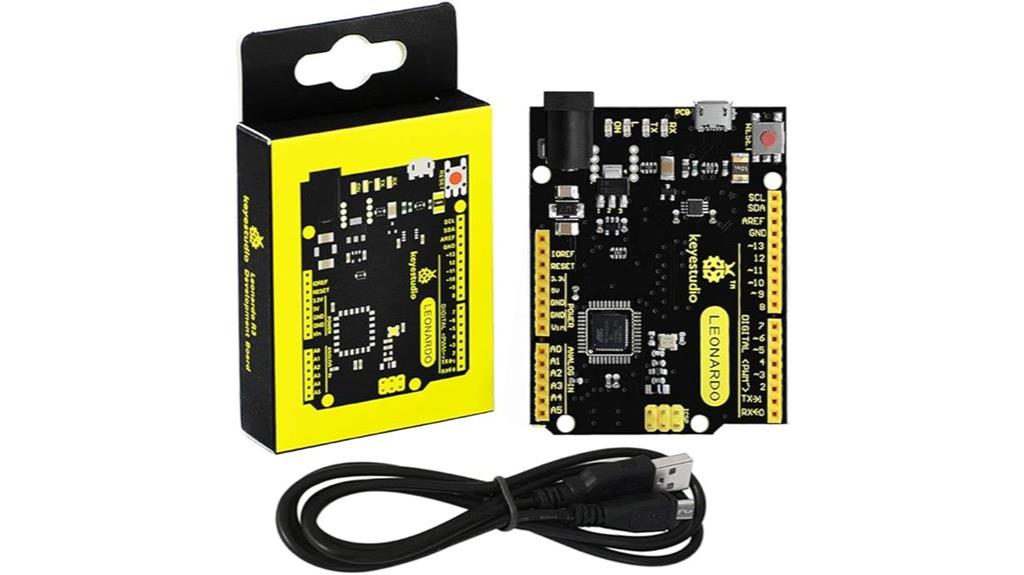
The KEYESTUDIO Leonardo R3 Microcontroller Development Board Kit stands out as an ideal choice for educators, students, and hobbyists seeking a versatile and Bluetooth-enabled microcontroller platform. Based on the ATmega32u4, it offers 20 digital I/O pins, 12 analog inputs, and Bluetooth Low Energy capabilities through the Nordic nRF51822 microcontroller. It supports programming via Arduino IDE and graphical tools like MakeCode, making it accessible for beginners. Compact and lightweight, it’s perfect for prototyping projects like HID devices, Bluetooth controls, and educational demos. Certified with FCC and CE, it guarantees reliable, environmentally friendly production, making it a trusted tool for innovation.
Best For: educators, students, and hobbyists looking for an easy-to-use, Bluetooth-enabled microcontroller platform for prototyping and educational projects.
Pros:
- Supports programming via Arduino IDE and MakeCode, making it accessible for beginners
- Compact, lightweight design suitable for various prototyping applications
- Certified with FCC and CE, ensuring quality and environmentally friendly production
Cons:
- Limited edge connector compatibility may require additional components like headers for breadboard use
- Slightly smaller size compared to standard Arduino boards could restrict space for complex projects
- Basic documentation may need supplementing with online resources for advanced features
ELEGOO 3PCS ESP-32 Development Board with USB-C and Dual Mode WiFi+Bluetooth
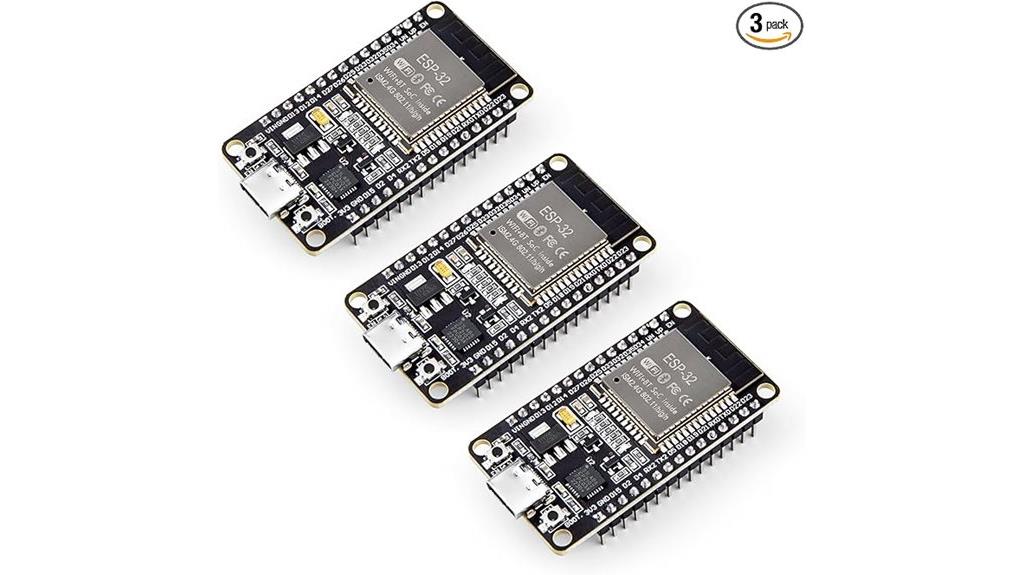
Designed for makers who need reliable wireless connectivity, the ELEGOO ESP-32 development board stands out with its dual-mode WiFi and Bluetooth support, making it ideal for IoT projects and remote device control. It features a powerful dual-core 32-bit processor running up to 240 MHz, ensuring smooth performance for complex applications. The board’s low-power architecture allows for efficient battery use, with dynamic clock scaling. It offers extensive peripherals, including GPIO, UART, SPI, and I2C, simplifying sensor and device integration. Plus, it supports OTA updates and is compatible with Arduino IDE, making development straightforward and flexible.
Best For: makers and developers seeking a reliable, versatile Wi-Fi and Bluetooth-enabled microcontroller for IoT projects and remote device control.
Pros:
- Dual-core 32-bit processor up to 240 MHz delivers strong performance for complex applications.
- Supports OTA firmware updates and is compatible with Arduino IDE, facilitating easy development and remote upgrades.
- Extensive peripheral options including GPIO, UART, SPI, and I2C simplify sensor and device integration.
Cons:
- Power management, while efficient, may require careful configuration for very low-power applications.
- The 2.4 GHz Bluetooth and Wi-Fi may face interference in crowded environments.
- Limited to specific connectivity protocols, potentially requiring additional modules for advanced features.
ESP-WROOM-32 Development Board (3-Pack) with WiFi & Bluetooth
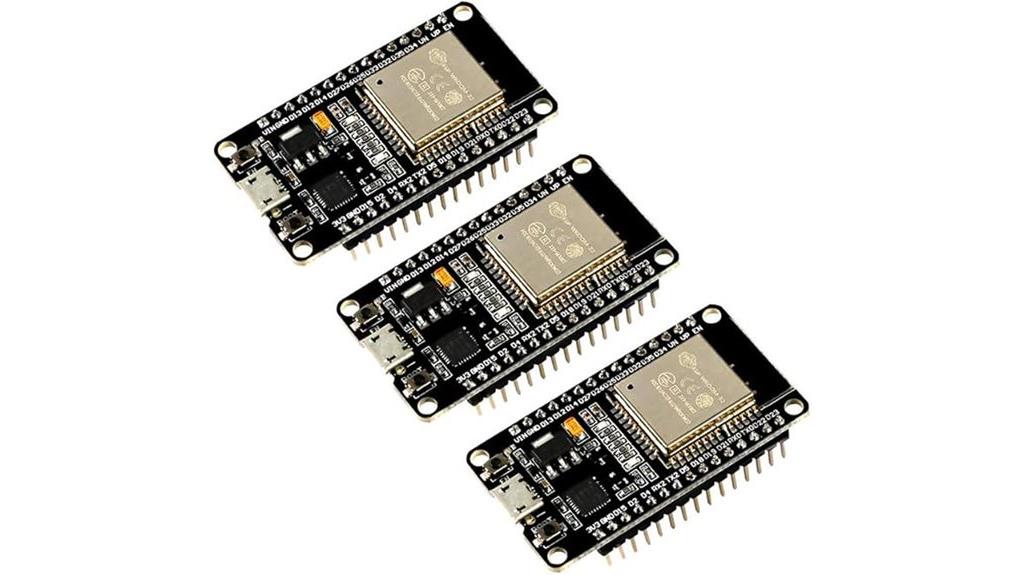
For makers and innovators seeking a versatile, compact microcontroller with robust wireless capabilities, the ESP-WROOM-32 Development Board (3-Pack) offers an excellent solution. It features dual-mode Wi-Fi and Bluetooth, powered by dual Tensilica LX6 cores running up to 240MHz. With 512kB RAM and support for multiple peripherals like ADCs, DACs, UART, SPI, and I2C, it’s highly adaptable for IoT, smart home, and automation projects. Its ultra-low power design enables battery operation, while compatibility with Arduino IDE and other platforms simplifies development. The pack of three boards makes it ideal for multiple projects, testing, or scalable applications, all at an affordable price point.
Best For: hobbyists, makers, and developers seeking an affordable, versatile microcontroller with robust Wi-Fi and Bluetooth capabilities for IoT, automation, and smart home projects.
Pros:
- Supports dual-mode Wi-Fi and Bluetooth (Classic and BLE) for flexible connectivity options
- Compatible with Arduino IDE and other platforms, facilitating easy development and customization
- Ultra-low power consumption suitable for battery-powered applications
Cons:
- Wi-Fi range may be limited in certain environments, with some users reporting weaker signals at longer distances
- Occasional issues with driver installation or setup complexity for beginners
- Slightly larger size compared to some microcontrollers, which may impact compact project designs
ELEGOO Nano Microcontroller Board with USB Cable Compatible with Arduino IDE
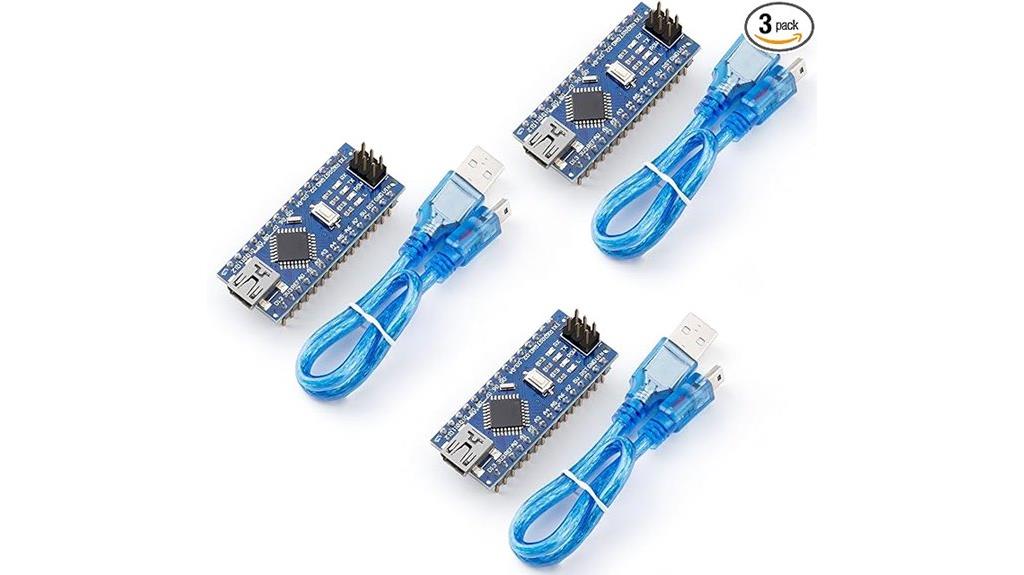
If you’re seeking an affordable yet reliable microcontroller board compatible with the Arduino IDE, the ELEGOO Nano offers a compelling option. It features an ATmega328P microcontroller and CH340 chip, making it suitable for beginners and experts alike. The compact, breadboard-friendly design comes with pre-soldered pins and a USB cable, simplifying setup. It supports various power sources, including USB and external supplies, and performs reliably for projects like robotics and avionics. Praised for its solid build quality and affordability, the ELEGOO Nano delivers the same functionality as the Arduino Nano at a lower cost, backed by extensive tutorials and positive user feedback.
Best For: hobbyists, students, and DIY enthusiasts seeking a reliable, affordable microcontroller board compatible with Arduino IDE for various electronics projects.
Pros:
- Compact, breadboard-friendly design with pre-soldered pins for easy setup
- Supports multiple power options including USB and external supplies for versatile use
- Trusted brand with positive user feedback and extensive tutorials for learning
Cons:
- USB-B connector considered outdated compared to micro or USB-C options
- Occasional GPIO pin labeling discrepancies may require testing and troubleshooting
- First unit may overheat during initial use, though overall performance remains reliable
Arduino Uno REV3 Microcontroller (A000066)
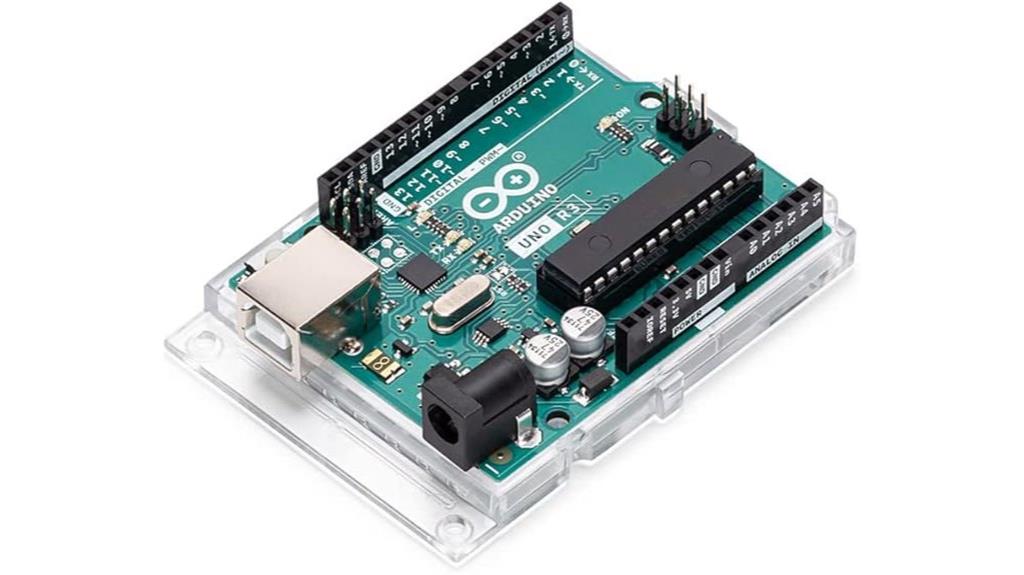
The Arduino Uno REV3 Microcontroller (A000066) stands out as an ideal choice for beginners and educators due to its straightforward programming environment and extensive community support. Powered by the ATmega328P at 16 MHz, it offers 32KB of flash memory, 14 digital I/O pins, and 6 analog inputs, making it versatile for many projects. Its compatibility with the Arduino IDE simplifies coding and access to countless libraries. Weighing just 1.6 ounces and measuring about 3.15 x 2.17 inches, it’s perfect for prototyping, robotics, IoT, and educational use. Reliable and easy to upgrade, this board remains a favorite among makers for its balance of performance and simplicity.
Best For: beginners, educators, and hobbyists seeking an easy-to-use, reliable microcontroller platform for prototyping and educational projects.
Pros:
- User-friendly programming environment with extensive community support and libraries
- Compact, lightweight design suitable for various projects and easy integration
- Reliable construction with good hardware quality and compatibility with shields
Cons:
- Some early units experienced soldering defects, although recent versions have improved
- Limited processing power for more complex applications compared to newer microcontrollers
- Initial driver detection issues on Windows 10 can occur, requiring updates
AYWHP Nano V3.0 Board with Cable (5 Pack)
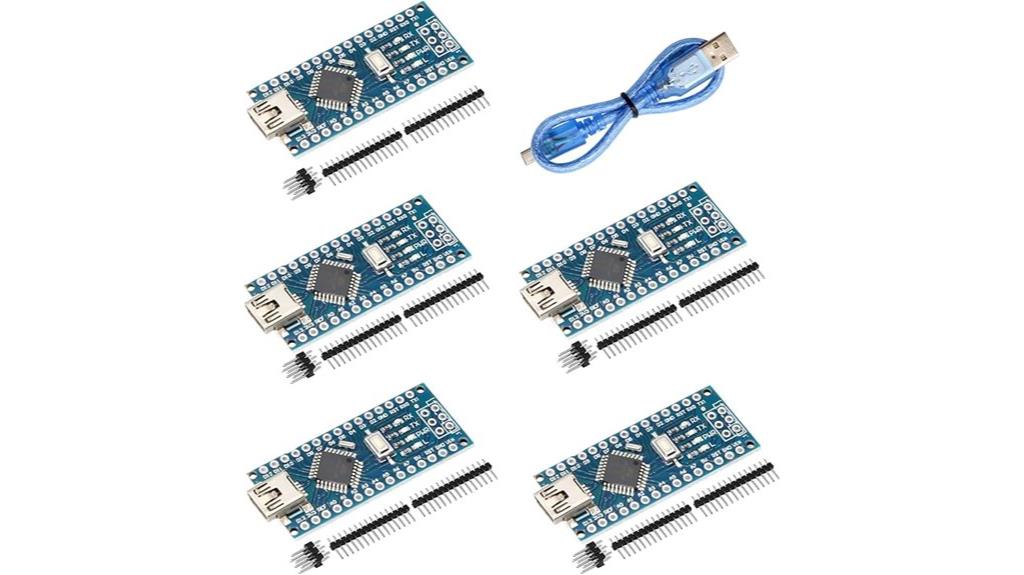
Looking for an affordable yet reliable microcontroller bundle ideal for beginners and educators? The AYWHP Nano V3.0 Board with Cable (5 Pack) fits the bill perfectly. It features the ATmega328P microcontroller and CH340G chip, ensuring cost-effective performance compatible with Arduino Nano. It supports Windows, Mac, and Linux, with easy USB and ISP programming. The board offers 14 digital I/O pins, 6 analog inputs, and multiple power options, including auto-switching between USB and external power. Designed for breadboarding and versatility, this pack provides a great entry point for microcontroller projects, making it a smart choice for learning, prototyping, and teaching.
Best For: beginners, educators, and hobbyists seeking an affordable, versatile microcontroller bundle for learning and prototyping projects.
Pros:
- Cost-effective with a 5-pack, ideal for multiple projects or classroom use
- Fully compatible with Arduino Nano, supporting multiple operating systems and easy USB/ISP programming
- Features multiple power options and breadboard-friendly design for versatile applications
Cons:
- Limited to the ATmega328P microcontroller, which may not support more advanced features of newer boards
- CH340G chip may require driver installation on some computers, potentially complicating setup
- No onboard Wi-Fi or Bluetooth, limiting wireless connectivity options
Nano V3.0 ATmega328P Micro-Controller Board (3-Pack with USB Cables)
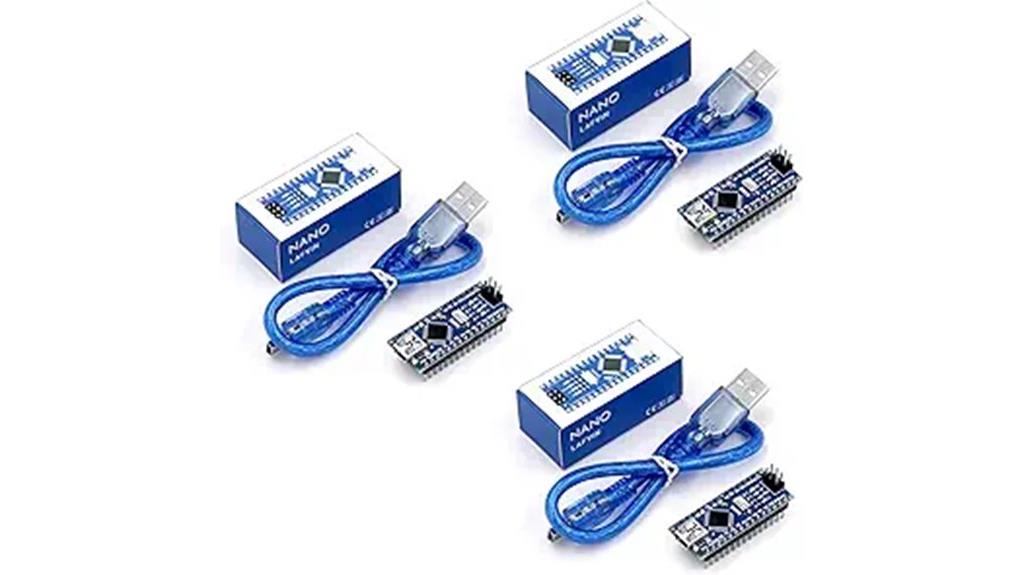
For makers and hobbyists seeking an affordable, reliable microcontroller solution, the Nano V3.0 ATmega328P Micro-Controller Board (3-Pack with USB Cables) stands out as an excellent choice. It includes three compact, breadboard-friendly boards compatible with Arduino IDE, featuring the improved CH340G chip for seamless Windows, Mac, and Linux integration. These boards support programming via USB, ISP, and power supply, making them versatile for communication, motor control, and projects. Praised for ease of use, solid build quality, and affordability at around $14 for three units, they’re perfect for quick prototyping and hobbyist experimentation.
Best For: hobbyists, students, and makers seeking an affordable, reliable microcontroller for quick prototyping and various DIY projects.
Pros:
- Compatible with Arduino IDE and standard libraries for easy programming
- Includes three compact, breadboard-friendly boards with USB cables for ready-to-use deployment
- Supports multiple programming methods (USB, ISP) and runs on Windows, Mac, and Linux platforms
Cons:
- Slightly smaller screws requiring special screwdrivers for assembly or adjustments
- Some users report initial driver recognition or bootloader setup issues
- Discontinued manufacturer product, potentially affecting long-term availability or support
Nano V3.0 Microcontroller Board with Cable (ATmega328P, USB-C)
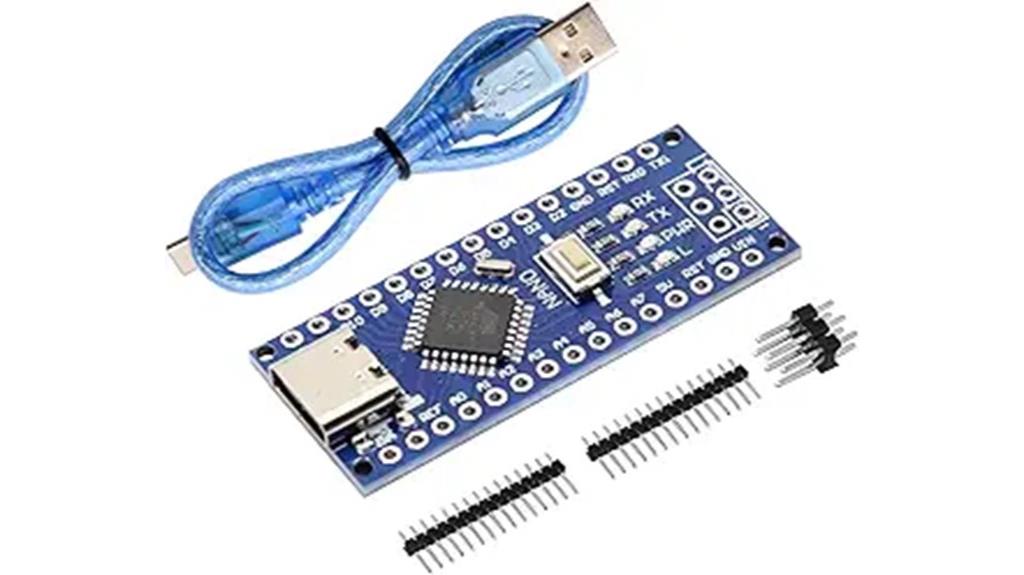
Designed with beginners and experienced makers in mind, the Nano V3.0 Microcontroller Board with Cable (ATmega328P, USB-C) stands out for its seamless compatibility with the Arduino IDE and modern USB-C connectivity. It features an ATmega328P microcontroller and CH340G chip, replacing the old FT232. Powered through USB-C, it supports 6-12V external power and auto-detects sources. With 14 digital I/O pins, 6 PWM, and 6 analog inputs, it’s versatile for various projects. Many users find it immediately functional, easy to solder, and budget-friendly, though some face driver setup challenges. Overall, it’s a reliable, beginner-friendly board perfect for hobbyists and innovators alike.
Best For: hobbyists, beginners, and experienced makers seeking a versatile, USB-C compatible microcontroller board for diverse DIY projects.
Pros:
- Seamless compatibility with Arduino IDE across multiple operating systems
- Modern USB-C connectivity for easy power and programming
- Cost-effective and beginner-friendly with straightforward soldering
Cons:
- Some users may encounter driver or recognition issues on Windows 11 or with IDE updates
- Short included USB-C cable may require an additional purchase
- Software interfaces are primarily in Chinese, which could pose a language barrier for some users
ELEGOO UNO R3 Board ATmega328P with USB Cable (Arduino-Compatible)
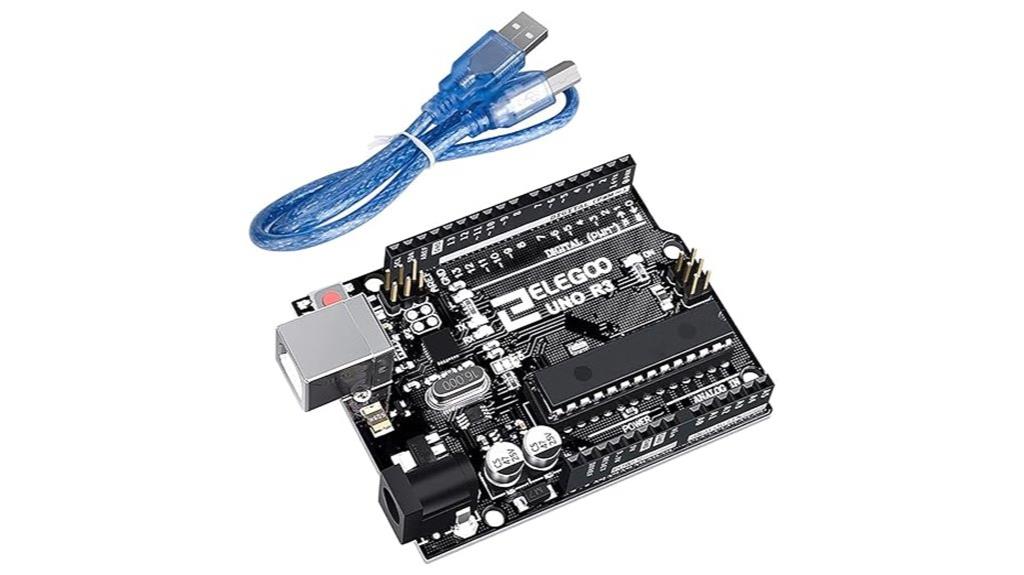
The ELEGOO UNO R3 Board ATmega328P with USB Cable stands out as an excellent choice for beginners and hobbyists seeking a reliable, Arduino-compatible microcontroller. It supports the Arduino IDE and libraries, making programming straightforward. The upgraded ATmega328P microcontroller and 16U2 chip deliver faster transfer rates and more memory, ensuring smooth operation. Its durable build, well-placed female headers, and included USB cable make setup easy. Ideal for learning, prototyping, and project development, the UNO R3 offers great value, compatibility, and community support. Overall, it’s a versatile, dependable platform that suits both newcomers and experienced makers alike.
Best For: beginners, hobbyists, and educators seeking a reliable, Arduino-compatible microcontroller for learning, prototyping, and project development.
Pros:
- Supports Arduino IDE and libraries for easy programming and compatibility
- Upgraded microcontroller and 16U2 chip ensure faster transfer rates and increased memory
- Durable build with well-placed headers and included USB cable for straightforward setup
Cons:
- Short USB cables or limited port options may require additional accessories
- Minor manufacturing variances like excess solder can be present but are easily fixed
- Some users may find the need for supplementary kits or parts for more complex projects
Arduino UNO R4 WiFi (ABX00087) for IoT & Embedded Projects
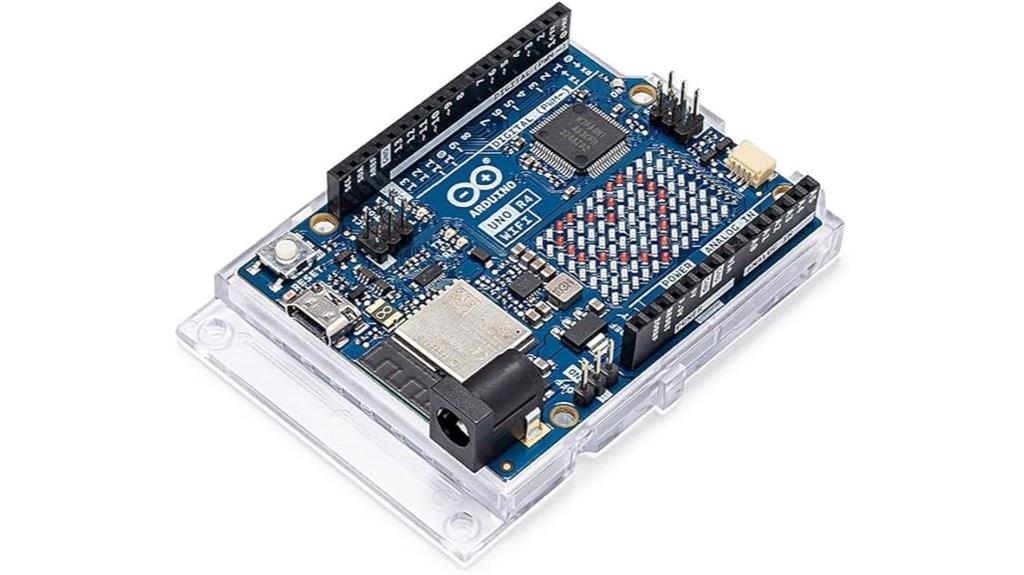
If you’re looking for a microcontroller board that combines powerful processing with seamless connectivity, the Arduino UNO R4 WiFi (ABX00087) stands out as an ideal choice for IoT and embedded projects. It features dual-core processors with Renesas RA4M1 (ARM Cortex-M4) and ESP32-S3 chips, ensuring high-speed performance. The board includes a 12-bit DAC, OP-AMP, and a built-in 12×8 LED matrix for real-time visual feedback. With Wi-Fi, Bluetooth 5.0, USB-C, and CAN support, it offers versatile communication options. Its user-friendly design, supported by freeRTOS and extensive documentation, makes it accessible for both beginners and seasoned developers.
Best For: hobbyists, students, and professionals seeking a powerful, versatile microcontroller platform for IoT, embedded, and interactive projects.
Pros:
- Dual-core processing with high-speed ARM Cortex-M4 and ESP32-S3 chips for demanding applications
- Built-in 12×8 LED matrix and integrated analog components like DAC and OP-AMP for real-time visual feedback and precise analog signals
- Extensive connectivity options including Wi-Fi, Bluetooth 5.0, USB-C, and CAN support, along with user-friendly features like the Qwiic Connector
Cons:
- Some users experience limitations with high-speed rotary encoder readings
- The complexity of dual-core architecture may present a learning curve for beginners
- Slightly higher cost compared to basic Arduino boards, which might be a consideration for budget-conscious projects
Nano V3.0 Board with Cable (5 pcs) for Arduino Nano
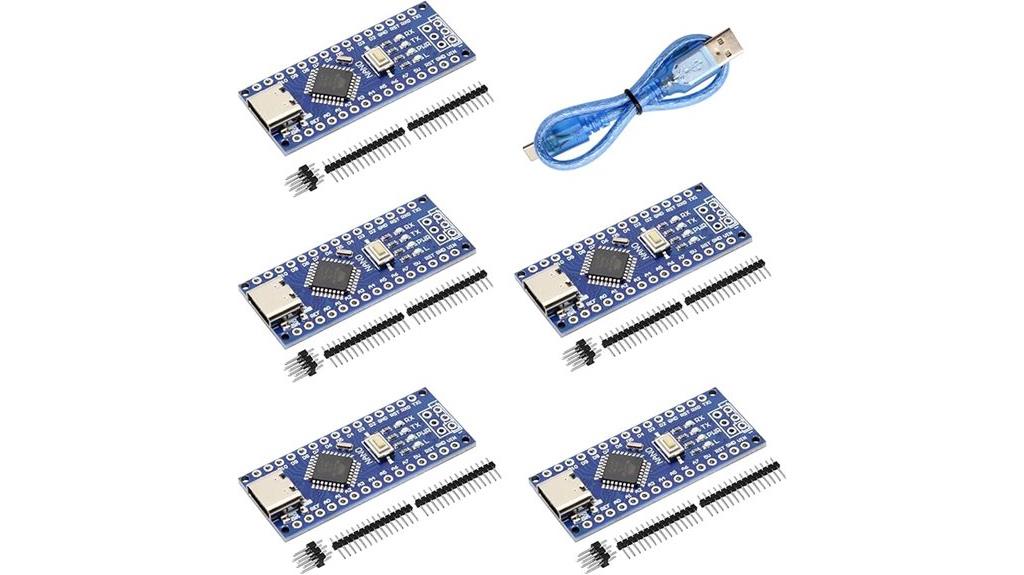
For makers and DIY enthusiasts seeking a versatile and reliable microcontroller, the Nano V3.0 Board with Cable (5 pcs) for Arduino Nano stands out due to its compatibility with the Arduino IDE and seamless integration with various operating systems. It features an ATmega328P microcontroller supporting USB programming, power supply options, and ISP. Its breadboard-friendly design includes 14 digital I/O pins, 6 PWM, and 6 analog inputs, making it perfect for prototyping. Powered via USB-C or external sources, it’s easy to use right out of the box, with many users praising its value, ease of use, and suitability for a range of projects.
Best For: DIY enthusiasts, students, and hobbyists seeking a cost-effective, versatile microcontroller for prototyping and educational projects.
Pros:
- Compatible with Arduino IDE and multiple operating systems, ensuring easy programming and integration.
- Breadboard-friendly design with multiple I/O pins, PWM, and analog inputs for diverse project applications.
- Supports USB-C power and programming, providing flexible power options and modern connectivity.
Cons:
- Some users experience driver or recognition issues on Windows 11 or with certain cables.
- Occasional soldering required for headers, which may be challenging for beginners.
- Power consumption may be higher due to limitations of the onboard USB-to-serial converter chip.
STM32 Nucleo Development Board with STM32F446RE MCU NUCLEO-F446RE
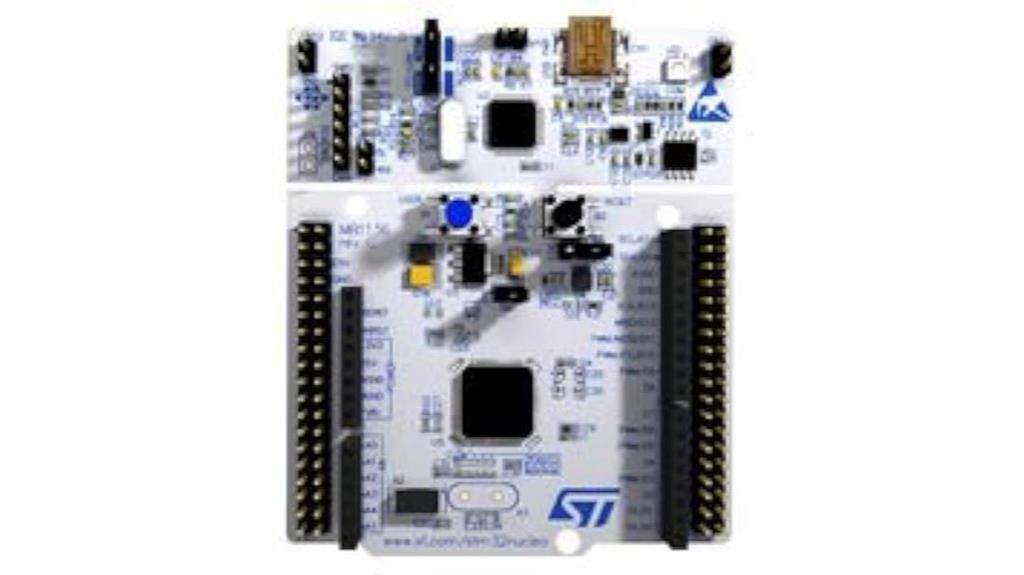
Designed for advanced developers and serious enthusiasts, the STM32 Nucleo Development Board with STM32F446RE MCU stands out with its powerful ARM Cortex-M4 core featuring DSP and FPU capabilities. It offers 512 KB of flash, runs up to 180 MHz, and includes the ART Accelerator and dual QSPI for fast data access. The onboard ST-LINK/V2-1 debugger and SWD connector simplify programming and debugging. With support for multiple IDEs like IAR, Keil, and GCC, setup is straightforward. Its versatile design includes Arduino headers, LEDs, and push-buttons, making it ideal for complex projects, prototyping, and learning embedded systems. It’s a robust, cost-effective platform for serious development.
Best For: advanced developers, educators, and serious electronics enthusiasts seeking a high-performance, versatile microcontroller platform for complex embedded projects and prototyping.
Pros:
- Powerful ARM Cortex-M4 core with DSP and FPU capabilities for intensive processing tasks
- Supports multiple IDEs like IAR, Keil, and GCC, facilitating flexible development environments
- Onboard ST-LINK/V2-1 debugger and SWD connector enable easy programming and debugging
Cons:
- Slightly higher cost compared to simpler Nucleo boards, though still cost-effective overall
- USB connector design may be unconventional, potentially requiring an older or compatible cable
- Initial setup can be slow for beginners unfamiliar with IDE configurations and debugging tools
HiLetgo ESP-WROOM-32 ESP32 Development Board with WiFi and Bluetooth

The HiLetgo ESP-WROOM-32 ESP32 Development Board stands out for its dual-mode WiFi and Bluetooth capabilities, making it an excellent choice for makers seeking versatile connectivity options. Its dual-core processor, integrated antenna with RF amplifier, and support for multiple WiFi and Bluetooth protocols guarantee reliable performance across various projects. The board operates in three modes—Access Point, Station, and combined—offering flexible networking. Plus, its ultra-low power consumption makes it ideal for battery-powered applications. Compatibility with Arduino IDE and support for FreeRTOS simplify programming and real-time operations. Overall, it’s a secure, scalable, and dependable microcontroller solution for a wide range of innovative projects.
Best For: Makers and developers seeking a versatile, reliable microcontroller with dual WiFi and Bluetooth connectivity for a wide range of IoT projects.
Pros:
- Supports multiple WiFi and Bluetooth protocols, offering flexible connectivity options
- Equipped with a dual-core processor and integrated antenna for reliable performance
- Compatible with Arduino IDE and FreeRTOS, simplifying development and real-time operations
Cons:
- Power management may require additional optimization for ultra-low power applications
- The complexity of multiple operating modes can be challenging for beginners
- Limited onboard peripherals may necessitate external modules for certain projects
3-Pack ESP32 Development Boards with USB-C, WiFi, Bluetooth, Dual-Core Microcontroller

If you’re looking to build versatile IoT projects or smart devices, packing your setup with ESP32 development boards that feature USB-C, WiFi, Bluetooth, and a dual-core microcontroller makes perfect sense. These boards are powered by a high-performance dual-core 32-bit CPU running up to 240MHz, ensuring smooth and efficient processing for embedded applications. They support dual-mode Wi-Fi and Bluetooth for wireless data transfer and remote control. With multiple interfaces like GPIO, UART, SPI, and I2C, plus functions such as touch sensing and infrared remote control, they’re incredibly versatile. Designed for low power, they’re ideal for battery-powered devices and support popular development platforms like Arduino IDE and MicroPython.
Best For: hobbyists, developers, and engineers looking to create versatile IoT projects and smart devices with powerful, easy-to-program microcontrollers.
Pros:
- High-performance dual-core 32-bit CPU up to 240MHz for efficient processing
- Supports multiple wireless protocols including dual-mode Wi-Fi and Bluetooth
- Wide range of interfaces (GPIO, UART, SPI, I2C) and functions (touch sensing, infrared remote control)
Cons:
- May require some technical knowledge to fully utilize all features
- Limited onboard storage capabilities for large projects
- Power management features might need careful configuration for optimal battery life
Factors to Consider When Choosing a Microcontroller Board
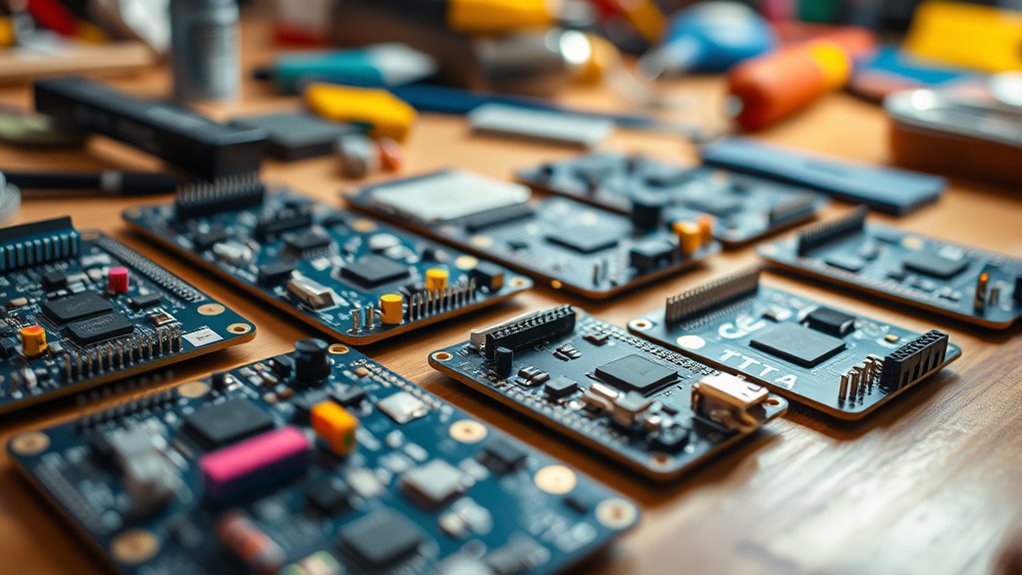
When choosing a microcontroller board, I focus on factors like power compatibility, supported programming languages, and connectivity options to match my project needs. Size and form factor also matter, especially if space is limited. Ultimately, I consider my budget to find options that offer the best value without sacrificing essential features.
Power Compatibility Requirements
Choosing a microcontroller board requires careful attention to power compatibility to guarantee it operates safely and reliably. First, I check that the board’s voltage needs align with my power source, usually 5V or 3.3V, to prevent damage or malfunction. I also verify if the board supports multiple power inputs like USB, an external jack, or batteries, which adds flexibility. Next, I examine the onboard voltage regulator’s specs to ensure it can handle my project’s current demands safely. It’s vital to confirm the power supply’s current capacity matches the board’s requirements to avoid underpowering or overloading. Lastly, I consider the power consumption profile, especially for battery-powered projects, to ensure the board delivers sufficient runtime and efficiency without draining power unnecessarily.
Supported Programming Languages
Selecting a microcontroller board involves considering the programming languages it supports, as this directly impacts ease of development and integration. Most boards support C and C++, which are standard for embedded work due to their efficiency and control. Many also support Python via MicroPython or CircuitPython, making scripting more accessible for beginners. For web developers, some boards—especially those based on ARM Cortex processors—allow programming in JavaScript through platforms like Espruino. Arduino-compatible boards typically use the Arduino IDE, simplifying coding in C/C++ with a user-friendly interface and extensive libraries. Additionally, more advanced microcontrollers may support languages like Lua, BASIC, or proprietary SDKs, offering flexibility for diverse coding preferences. Choosing a board aligned with your preferred language helps streamline your development process.
Connectivity and Expansion Options
Connectivity and expansion options play a critical role in determining how versatile and future-proof your microcontroller board will be. I look for a variety of communication interfaces like UART, I2C, SPI, and USB to guarantee compatibility with my peripherals and sensors. The number and types of digital and analog I/O pins are essential, as they support multiple expansion modules and custom circuitry. I also check if the board has dedicated headers, shields, or expansion slots for easy stacking or attaching additional modules. Wireless connectivity options like Bluetooth, Wi-Fi, or Ethernet are indispensable if my project needs wireless communication. Finally, I verify compatibility with common development platforms and libraries to simplify integration and ensure scalability for future upgrades.
Size and Form Factor
The size and form factor of a microcontroller board are essential because they determine how well it fits into your project space and interacts with other components. Compact boards, such as those measuring around 45×18mm, excel in tight spaces and wearable devices, while larger boards provide more I/O ports and peripheral options. Thinner and smaller designs make integration into embedded systems, drones, or portable gadgets easier, reducing bulk and weight. The physical dimensions also influence the placement of connectors, pins, and mounting holes, affecting connection ease and stability. Choosing the right size ensures your board fits seamlessly into your project without unnecessary bulk or weight, maintaining portability and design flexibility. Proper sizing helps optimize space and functionality for your specific application.
Price and Budget Constraints
When choosing a microcontroller board, considering your budget helps guarantee you get the best value for your money. First, determine your budget range to narrow down options and avoid overspending on features you don’t need. Keep in mind the cost per unit when buying multiple boards, especially for larger projects, to ensure overall affordability. While higher-priced boards often include advanced features, many budget-friendly options still deliver reliable performance for most applications. Don’t forget to factor in additional costs, such as accessories, cables, or shields, which can add up. By balancing your financial constraints with your technical needs, you can select a microcontroller board that offers excellent value without compromising essential functionality.
Availability and Community Support
Choosing a microcontroller board with strong community support can considerably speed up your development process, as you’ll have access to tutorials, troubleshooting tips, libraries, and shared projects. A vibrant community means you’ll find answers quickly and discover new ideas through active forums, user groups, and manufacturer resources. Availability of boards can fluctuate due to supply chain issues, affecting lead times and stock levels, especially for popular or niche models. Well-established communities also foster a broader ecosystem of compatible accessories, shields, sensors, and software tools, increasing project versatility. The size and activity level of the community often determine the richness of third-party tutorials, code snippets, and project inspiration, making learning and innovation more accessible and less frustrating.
Frequently Asked Questions
Which Microcontroller Boards Offer the Best Power Efficiency for Portable Projects?
I find that microcontroller boards like the ESP32 and STM32 series excel in power efficiency, making them perfect for portable projects. They offer deep sleep modes and low power consumption, helping extend battery life. I often choose these boards because they balance performance with energy savings. If you’re aiming for long-lasting, portable devices, I highly recommend exploring these options—they’ve proven their efficiency in my projects time and again.
How Do Different Microcontrollers Handle Real-Time Processing Tasks?
Different microcontrollers handle real-time processing in various ways. I’ve found that microcontrollers with dedicated hardware timers and interrupt systems, like ARM Cortex-M series, excel at managing real-time tasks efficiently. They respond quickly to events without heavy software overhead, ensuring precise timing. I prefer boards that support real-time operating systems (RTOS) or have low-latency interrupt responses, as these features make handling time-critical tasks much more manageable and reliable.
What Are the Compatibility Considerations With Various Sensors and Peripherals?
Did you know that over 80% of projects face compatibility issues due to sensor and peripheral mismatches? I always check a microcontroller’s pin count, voltage levels, and supported communication protocols before starting a project. It’s essential to verify your chosen board supports your sensors’ interfaces—like I2C, SPI, or UART—and voltage requirements. This saves time, prevents damage, and guarantees seamless integration for your innovative creations.
Which Boards Provide the Most Extensive Community Support and Documentation?
If you’re looking for boards with the most extensive community support and documentation, I recommend Arduino and Raspberry Pi. I’ve found their vast online communities, tutorials, and forums incredibly helpful for troubleshooting and project ideas. These platforms have been around for years, making it easy to find resources and guidance. Plus, their widespread use means you’re never alone when facing challenges or exploring new projects.
How Scalable Are These Microcontrollers for Complex or Multi-Module Projects?
Like a trusty Swiss Army knife, these microcontrollers are quite scalable for complex projects. I’ve used them to handle multi-module setups, and they perform well, especially with proper planning. While some boards excel in handling numerous connections and data processing, others might need additional shields or modules. Overall, with the right choice and design, I find they’re versatile enough for big, multi-layered projects, just like a classic multitool.
Conclusion
Choosing the right microcontroller board is like selecting the perfect compass for your journey—guiding your ideas through uncharted territories. Whether you seek the compact agility of Nano, the versatile power of ESP32, or the robust strength of STM32, each board is a beacon in your innovation voyage. Trust your instincts, pick what resonates with your project’s spirit, and let your creativity light the way, transforming your visions into reality.
